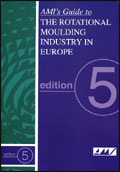ROTATIONAL MOULDING
"Significant" growth in Europe / Consumption will reach 288,000 t in 2011 / AMI report
In 2006, rotational moulding accounted for less than 1% of polymer consumption in Europe and involved just over 300 companies, according to the latest guide to "The Rotational Moulding Industry in Europe" published by Applied Market Information (AMI, Bristol / UK; www.amiplastics.com). The UK is the largest market, accounting for 19% of polymer consumed in 2006. The researcher said that the industry had enjoyed significant growth over the past 16 years. Annual consumption of thermoplastics in rotational moulding is currently 248,000 t and is predicted to reach 288,000 t in 2011.
In Europe the bulk of polymer used for rotational moulding is LLDPE, accounting for 90% of the material used in 2006, the report says. Of these volumes the majority are C4 varieties, although AMI says the use of metallocene-based C6 material from Borealis and C8 resins from Dow have increased substantially in recent years. Other polymers used are largely conventional LDPE and HDPE.
In Europe the bulk of polymer used for rotational moulding is LLDPE, accounting for 90% of the material used in 2006, the report says. Of these volumes the majority are C4 varieties, although AMI says the use of metallocene-based C6 material from Borealis and C8 resins from Dow have increased substantially in recent years. Other polymers used are largely conventional LDPE and HDPE.
 | |
At around 50%, the largest identifiable market for the process is in the manufacture of tanks and waste containers where there has been a trend to replace metal and GRP containers. The process is also used in the production of a wide range of products including toys, truck parts, plant pots, surf boards, kayaks and road barriers.
There has been an increasing trend for its use across Europe particularly in markets requiring small volumes of large mouldings, AMI says. Scandinavia is a good example of this, where there has been rapid development in the use of rotational moulding in recent years. The small local markets in the Nordic region for products such as boats, floats and buoys are ideally suited to production by rotational mouldings.
The majority of producers using the process are small businesses, with 200 of the 315 companies listed in the guide privately owned. However the industry has seen some consolidation in recent years, the report says.
 |
Book Service:
AMI´s Guide to "The Rotational Moulding Industry in Europe", 5th edtition, 2007, 190 pages, softcover: EUR 255.00 + VAT, PIE-No. 47195
CD-ROM, Gold Edition: EUR 510.00 + VAT, PIE-No. 47200
AMI´s Guide to "The Rotational Moulding Industry in Europe", 5th edtition, 2007, 190 pages, softcover: EUR 255.00 + VAT, PIE-No. 47195
CD-ROM, Gold Edition: EUR 510.00 + VAT, PIE-No. 47200
29.03.2007 Plasteurope.com [207680]
Published on 29.03.2007

 German version of this article...
German version of this article...